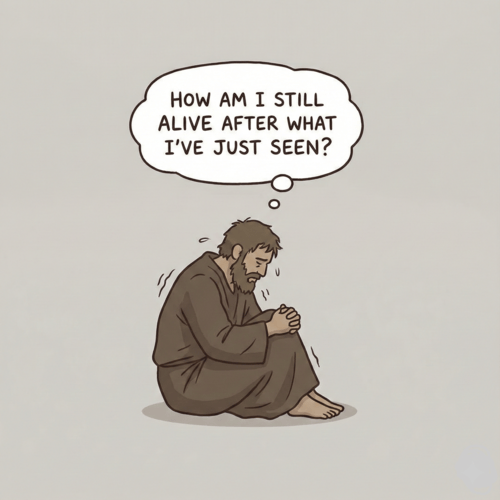End-Time Babylon: Cracking the Prophetic Mystery
Few images in Bible prophecy are as haunting and complex as the mysterious Babylon of Revelation. More than a historical footnote or a mere geographical location, this prophetic symbol represents a profound spiritual and systemic rebellion against God that transcends time and culture…
THE SPIRITUAL LANDSCAPE OF BABYLON
In Scripture, Babylon emerges as more than just an ancient Mesopotamian empire. It’s an archetype of human pride, rebellion, and spiritual apostasy. From the prideful tower of Babel (Genesis 11) to the prophetic warnings in Isaiah and the apocalyptic visions of Revelation (Chapters 17-18), Babylon is a picture of human pride and rebellion.
In the Reformed theological tradition, Babylon in prophecy is seen not as a literal city, but as a comprehensive system of world power that stands in direct opposition to the kingdom of God. This interpretation sees Babylon as a corporate entity—a collective manifestation of spiritual rebellion that finds expression through political, economic, and religious structures. The apostle John’s vision in Revelation (Chapters 17-18) provides a multi-layered symbolic representation of this systemic rebellion, echoing prophetic warnings from Isaiah and Daniel about worldly powers that set themselves against God’s divine plan.
Remember Old Testament prophecies that Babylon would never be rebuilt?
The prophetic declarations in Isaiah 13 and Jeremiah 50 promised Babylon would become an eternal wasteland, never to be restored to its former glory. Historical attempts to rebuild the city by various rulers, including Alexander the Great, have consistently failed, standing as a remarkable testament to biblical prophetic accuracy. This ongoing desolation serves as a powerful reminder of God’s ultimate judgement on systems of human pride and rebellion.
REVELATION 17 AND 18: UNMASKING THE WOMAN AND THE BEAST
In the prophetic vision of Revelation 17 and 18, the apostle John is summoned to witness a symbolic representation of spiritual corruption and divine judgement. The vision presents a woman adorned in royal splendour, seated upon a scarlet beast with seven heads and ten horns—a metaphorical depiction of the interplay between religious apostasy and political power. The woman, described as the “great prostitute,” represents a global system that seduces nations, merchants, and peoples into a corrupt spiritual and economic alliance that stands in direct opposition to God’s kingdom.
The symbolism is rich with theological significance. The beast represents political power—brutal, aggressive, and seemingly invincible. The woman symbolises a religious-economic system that prostitutes itself by compromising spiritual truth for worldly influence. From a Reformed perspective, the vision isn’t about a single historical moment, but a recurring spiritual reality that finds its ultimate expression in end-time rebellion. The woman’s attire of purple and scarlet, her golden cup filled with abominations, and her intoxication with the blood of saints all point to a comprehensive system that actively persecutes true believers while maintaining an appearance of power and prosperity.
The dramatic conclusion of this vision reveals the ultimate fate of this corrupt system. The very political powers that initially supported the woman turn against her, stripping her of her wealth and power. This sudden destruction symbolises the temporary nature of human systems that set themselves against God. The merchants of the earth mourn her fall, highlighting the economic devastation, while heaven rejoices—a powerful contrast that underscores the ultimate triumph of God’s sovereign plan. Reformed theology sees this not as a narrative of despair, but as a profound declaration of hope: no matter how powerful worldly systems may appear, they’re ultimately subject to God’s judgement.
IDENTIFYING THE BABYLONIAN SYSTEM
The Bible describes several key characteristics of this end-time system
- A global economic network that seduces nations and merchants
- A religious framework that compromises spiritual truth
- A political power that persecutes faithful believers
- A system marked by profound spiritual deception
These traits aren’t confined to a single historical moment but represent an ongoing spiritual reality that reaches its climax in the end times. The apostle John’s vision in Revelation portrays this system as a woman riding a beast—a potent symbol of how political power and corrupt spiritual influence work together.
END-TIME BABYLON: MULTIPLE THEOLOGICAL PERSPECTIVES
Reformed Understanding
Reformed theologians are careful to approach the prophecy with a Christ-centred hermeneutic. While the details may be mysterious, the ultimate message is clear: God’s sovereignty will triumph over all human systems of rebellion.
Alternative Christian Interpretations
The body of Christ offers diverse perspectives on this prophecy:
- Roman Catholic scholars often view Babylon through the lens of historical empires, seeing potential connections to political powers that have opposed the church.
- Eastern Orthodox traditions tend to interpret these passages more symbolically, focusing on the spiritual lessons rather than specific geopolitical predictions.
- Dispensationalist approaches often lean towards a more literal interpretation, anticipating a specific future geopolitical entity.
CONTEMPORARY RELEVANCE
While avoiding sensationalism, we cannot ignore the prophetic parallels in our current global landscape. The Babylonian system represents:
- Systemic economic injustice
- Religious syncretism
- Political structures that marginalise true faith
- A global network that prioritises human achievement over divine sovereignty
CONCLUSION: HOPE BEYOND THE PROPHECY
Despite the darkness the vision portrays, the message of Revelation is ultimately one of hope. The Babylonian system, powerful as it may seem, is destined for divine judgement. The New Jerusalem—representing Christ’s eternal kingdom—will triumph.
For believers, the prophecy isn’t about fear but about faithful living:
- Maintain spiritual discernment
- Resist systemic compromise
- Stay anchored in Bible truth
- Live with an eternal perspective
Babylon reminds us human systems, no matter how powerful, are temporary. Our citizenship is in a kingdom not made by human hands—an eternal, unshakable kingdom.
The mystery of Babylon isn’t meant to paralyse us with fear, but to represent the profound spiritual battle we’re engaged. In understanding this prophecy, we are called to wisdom, discernment, and unwavering faith.
END-TIME BABYLON: RELATED FAQs
What does Babylon symbolise in biblical prophecy? Babylon transcends its historical origins to represent a profound spiritual archetype of rebellion against God. From the tower of Babel to the apocalyptic visions in Revelation, Babylon emerges as a powerful symbol of human pride and systemic opposition to divine purposes. It embodies the persistent human tendency to establish kingdoms and systems that deliberately stand apart from God’s sovereign design.
- Is end-time Babylon a literal place or a spiritual concept? Reformed theological interpretation views Babylon primarily as a spiritual and systemic concept rather than a specific geographical location. This perspective sees Babylon as a comprehensive manifestation of worldly power that operates through political, economic, and religious structures that stand in direct opposition to God’s kingdom. While some traditions anticipate a literal future city, the biblical narrative suggests a more nuanced understanding of spiritual rebellion.
- What are the characteristics of the Babylonian system? The Babylonian system is characterised by a comprehensive network of spiritual, political, and economic rebellion against God’s kingdom. It manifests through global systems that prioritise human achievement, economic exploitation, and spiritual compromise over divine truth. This system is marked by its ability to seduce nations, marginalise true faith, and create alternative narratives that compete with biblical revelation.
- How do different Christian traditions interpret the Babylon prophecy? Christian traditions offer diverse perspectives on the Babylon prophecy, reflecting the complexity of apocalyptic interpretation. Reformed traditions emphasise a spiritual and systemic understanding, while Roman Catholic scholars often explore historical connections to past empires. Dispensationalist approaches tend toward more literal future-oriented interpretations, and Eastern Orthodox traditions focus on the symbolic and spiritual lessons embedded In the prophecy.
- How do we recognise systemic rebellion in our own context? Recognising systemic rebellion requires spiritual discernment and a deep understanding of biblical principles. Believers are called to identify structures and narratives that prioritise human achievement over divine truth, whether in political, economic, or religious spheres. This involves critically examining cultural systems that marginalise faith, compromise spiritual integrity, or create alternative value systems that compete with biblical worldviews.
What are the spiritual implications of the Babylon prophecy? The Babylon prophecy offers profound spiritual insights into the nature of divine sovereignty and human rebellion. It reminds believers that human systems, no matter how powerful, are ultimately temporary and subject to divine judgment. The prophecy calls Christians to maintain spiritual vigilance, resist cultural compromise, and live with an eternal perspective that prioritises God’s kingdom over worldly systems.
END-TIME BABYLON: OUR RELATED POSTS
Editor's Pick

The Throne-Room Vision: Who Did Isaiah See?
The scene is unforgettable: Isaiah stands in the temple, and suddenly the veil between heaven and earth tears open. He [...]

The Angel of the Lord: Can We Be Certain It Was Christ All Along?
Throughout the Old Testament, a mysterious figure appears: the Angel of the LORD. He speaks as God, bears God’s name, [...]
SUPPORT US:
Feel the Holy Spirit's gentle nudge to partner with us?
Donate Online:
Account Name: TRUTHS TO DIE FOR FOUNDATION
Account Number: 10243565459
Bank IFSC: IDFB0043391
Bank Name: IDFC FIRST BANK






